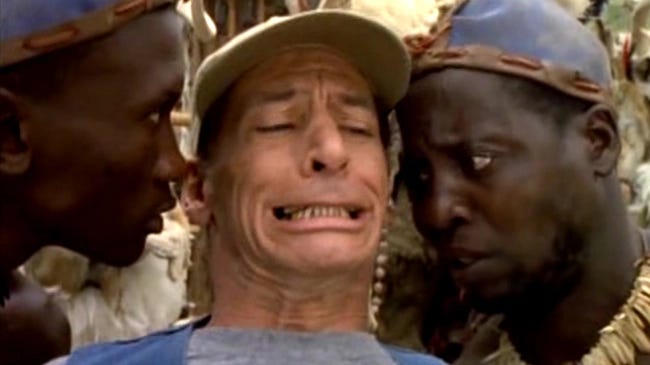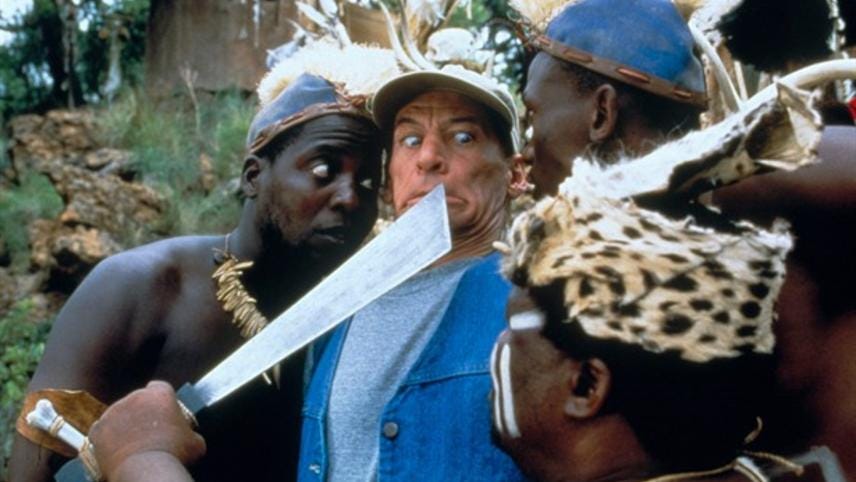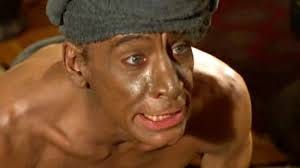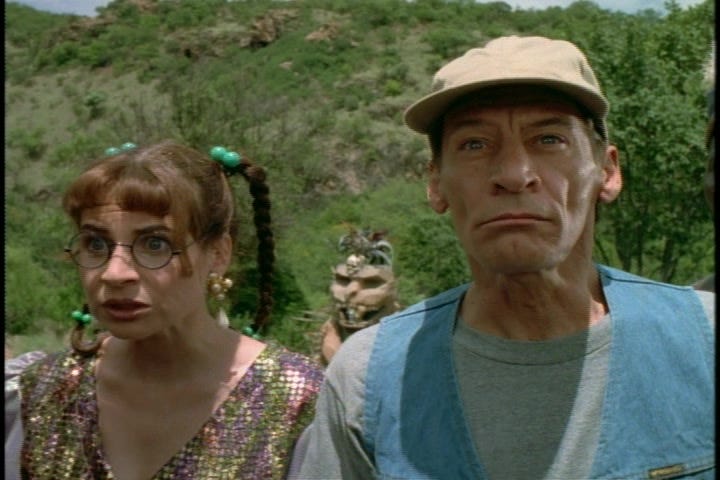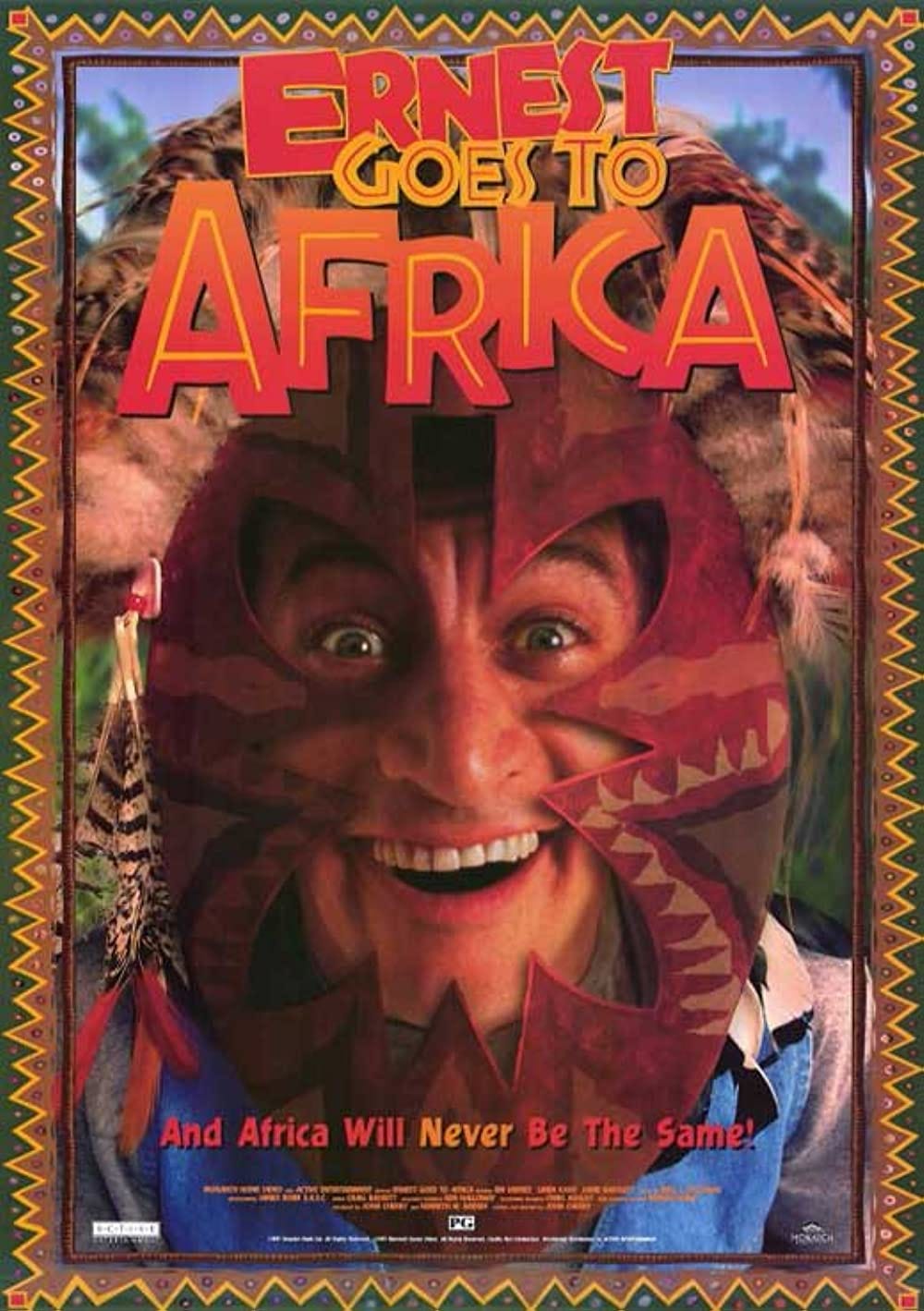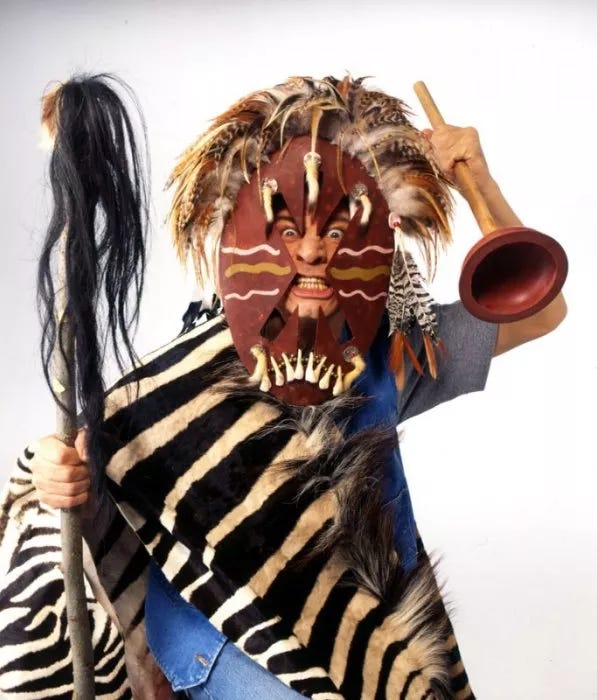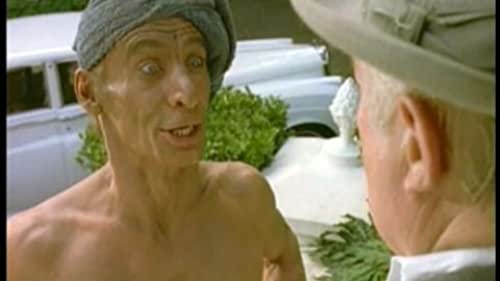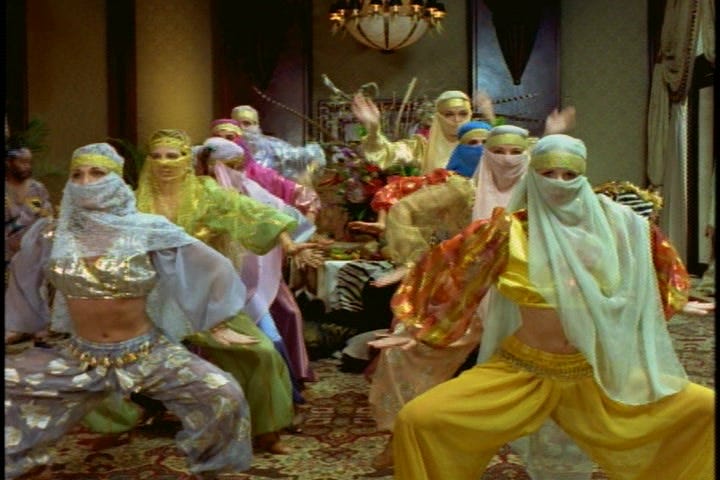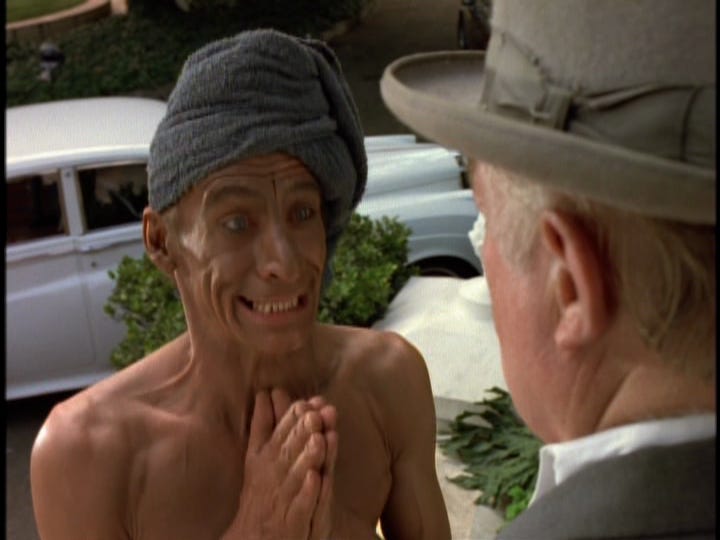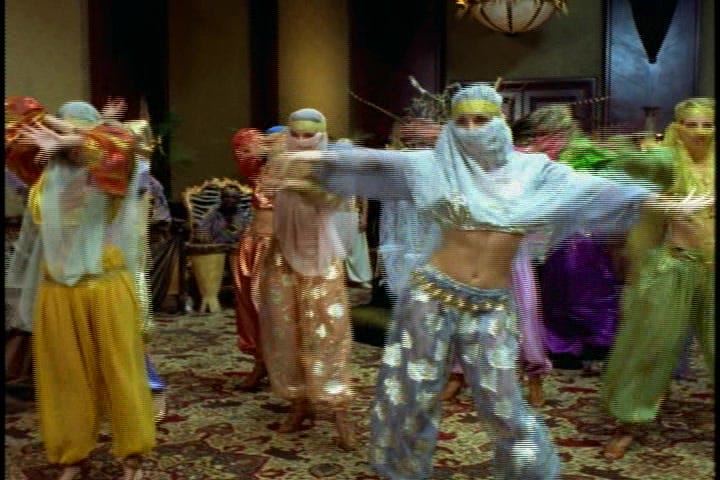My Journey Through the Films of Ernest P. Worrell Hits a Bleak Nadir With 1997's Deeply Unfortunate Ernest Goes to Africa
It's just as dire as you'd imagine.
This is just getting sad.
It’s heartbreaking, is what it is. The story of Ernest and film began in triumph, with a hayseed savant of the local commercial universe scoring a boffo box office for his 1987 starring debut, Ernest Goes to Camp.
By the time Ernest Goes to Africa was dumped direct to video in 1997, things had taken quite a turn. He was no longer working with Disney, and his movies were no longer released theatrically or reviewed widely. The budgets shrank as he went from filming in Nashville to Canada and, ultimately, South Africa, where he shot his final two vehicles back to back. Ernest Goes to Africa is consequently the first time racism has tainted South Africa’s Racial Utopia.
When Varney starred in Ernest Goes to Africa, he had been playing Ernest for seventeen LONG years and making Ernest movies for a solid decade.
As I have written before, slapstick and physical comedy are a young man’s game. It's funny when a man in his twenties or thirties executes a pratfall. When a man in his fifties falls down, it’s just sad. You worry about the poor man’s health. What if he broke a bone or sprained something? You feel bad for him. It’s just not dignified.
In Ernest Goes to Africa, Jim Varney is like a legendary baseball player who insists on playing well into his forties even when it’s obvious to everyone that he’s lost a step or two or three and retirement beckons.
Varney's potent combination of energy and precision is one of the many things that impressed me about Varney’s early films.
Critics and the intelligentsia may have written off Varney and his signature character as a dim-witted buffoon for dullards, but he possessed a photographic memory that allowed him to learn reams and reams of dialogue almost instantly and record dozens of different variations of the same commercial in the same day.
By 1997, however, decades of chain smoking and hard living were starting to catch up with Varney. He was only a few years away from dying young of lung cancer and had begun to look his age.
Varney probably should have stopped making Ernest movies after Ernest Goes to School, but it’s hard to turn down money and work, even of the most regrettable variety, and Ernest Goes to Africa is a deeply unfortunate enterprise.
At the risk of stating the obvious, Ernest NEVER should have gone to Africa. It’s a terrible idea for any number of reasons, most having to do with race and racism.
During the Touchstone years, Disney perversely insisted that Ernest be as sexless and devoid of genitalia as a Ken doll. They couldn’t handle Varney’s raw sexuality and big dick energy, so they castrated him creatively.
In Ernest Goes to Africa, Ernest has a love interest who scores nearly as much screen time as he does, but her presence suggests that Disney is right.
Linda Kash, who appeared in two previous Ernest adventures in different roles, plays the female lead, Rene Loomis. She’s a small-town waitress who longs to escape her humdrum little world for a life of adventure and intrigue.
Ernest, who honestly comes off as a bit of an incel here, nurses a desperate crush on the food-slinging dreamer, but she rejects him for not being worldly or exciting enough, for being a quintessential “Nice Guy” instead of a studly, womanizing “Chad.”
Our hillbilly hero, unfortunately, cannot take no for an answer, so he goes to a flea market to buy her a present and, through complications too stupid to go into, ends up somehow stumbling across two massive diamonds collectively known as Eyes of Igoli, which are sacred to the Sinkatutu tribe of Africa.
Ernest Goes to Africa offers audiences an Indiana Jones-style adventure with all of the racism, colonialism, and ancient stereotypes and none of the adventure or fun. What Ernest Goes to Africa does have is a level of violence and brutality wildly inappropriate for a movie pitched exclusively to small, stupid children.
It’s filled with knives, deadly snakes, and crude caricatures of sweaty, desperate criminality squaring off against one another in a pointless quest for the MacGuffin at the film’s core.
Ernest Goes to Africa depicts its setting as a violent realm of barbarism and brutality populated by heartless criminals eager to murder adversaries with poisonous snakes, shiny, gleaming knives, or various other instruments of deadly destruction.
I’m talking about sinister figures out of the imperialist imagination like Bazoo, a dark-skinned African enforcer who takes great delight in terrorizing people on behalf of a white boss who treats him with undisguised contempt.
Bazoo wants to physically and/or sexually assault Rene, but this is a PG-rated Ernest movie for the whole family, so there are clear intimations of sexual violence but never anything explicit.
Life is cheap, and death is everywhere here. That’s a strange, unfortunate choice for a movie about a formerly lovable and previously amusing country-fried goober.
An oblivious Ernest turns the diamonds everyone wants into a yo-yo without realizing that the stones he bought for a dollar are priceless treasures.
Ernest is dumb enough to leave his name and whereabouts at the flea market stall where he unknowingly bought the Eyes of Igoli from a sleeping merchant.
Shortly after Rene rejects Ernest for being “just a small town ordinary schmo,” they’re kidnapped and taken to Africa by bad guys who are convinced that they know the location of the sought-after jewels.
For reasons I cannot understand, in the 1980s and 1990s, broad comedies targeted at kids and family audiences were inexplicably obsessed with the international black market for precious jewels and filled with diamond smuggling subplots no one could care about.
Ernest Goes to Africa is sadly representative of this curious breed, although, to be fair, making this Ernest adventure diamond smuggling-themed does facilitate much of the racism and violence of its peculiar raison d’etre.
Ernest and his would-be girlfriend end up pawns in a high-stakes war between vicious smuggler Mr. Thompson (Jamie Bartlett), Bazoo’s rage-poisoned boss, and Prince Kazim (Robert Whitehead), a sleazy royal obsessed with tracking down the Eyes of Egoli.
To find Rene Ernest slathers on darkening make-up makes a turban out of what appears to be a towel, borrows Peter Sellers’ accent from The Party, and does brown face as “Hey-Yu.”
I had a strong hunch that Ernest Goes to Africa would prominently feature either brown or blackface despite being released in 1997 rather than 1927.
That’s the implicit threat of the film’s title and premise. Since Ernest Goes to Africa is every bit as bad, racist, and problematic as you think it would be, if not worse, it most assuredly does include unconscionable and unforgivable, not to mention un-funny brownface when Ernest darkens up to portray a sniveling sycophant derided as a filthy urchin by the criminal scum he’s trying to impress.
The subterfuge and role-playing continue when Ernest resurrects his gloomy, hectoring Aunt Nelda character before Ernest goes undercover as a harem girl in Prince Kazim’s harem in a set piece that seems to last several days, if not months.
Ernest tries to communicate with a South African tribe through a crude approximation of 1970s jive talk, addressing them as “homies” and asking, “What is happening?” They initially propose ripping his arms off and chopping off his legs before smacking him on the head with a stick, knocking him unconscious before being inexplicably won over by his hillbilly shtick.
In a running gag that limps, Ernest talks about turning on the old “Worrell charm” when he’s never been less charming or appealing.
Ernest Goes to Africa ends with its female romantic lead rejecting its male romantic lead in favor of a boring nobody whose only real strength is that he’s not Ernest P. Worrell. It’s a perverse anti-climax that seems to acknowledge that its hero has never been less appealing.
Ernest Goes to Africa isn’t just sub-theatrical quality. It’s sub-direct-to-video as well. When people think of Ernest movies as dumb and embarrassing, unfunny and vulgar, they’re talking about this.
I never thought I would write these words, but this African-themed, late-period Ernest movie is more than quite poor: it’s an abomination.




